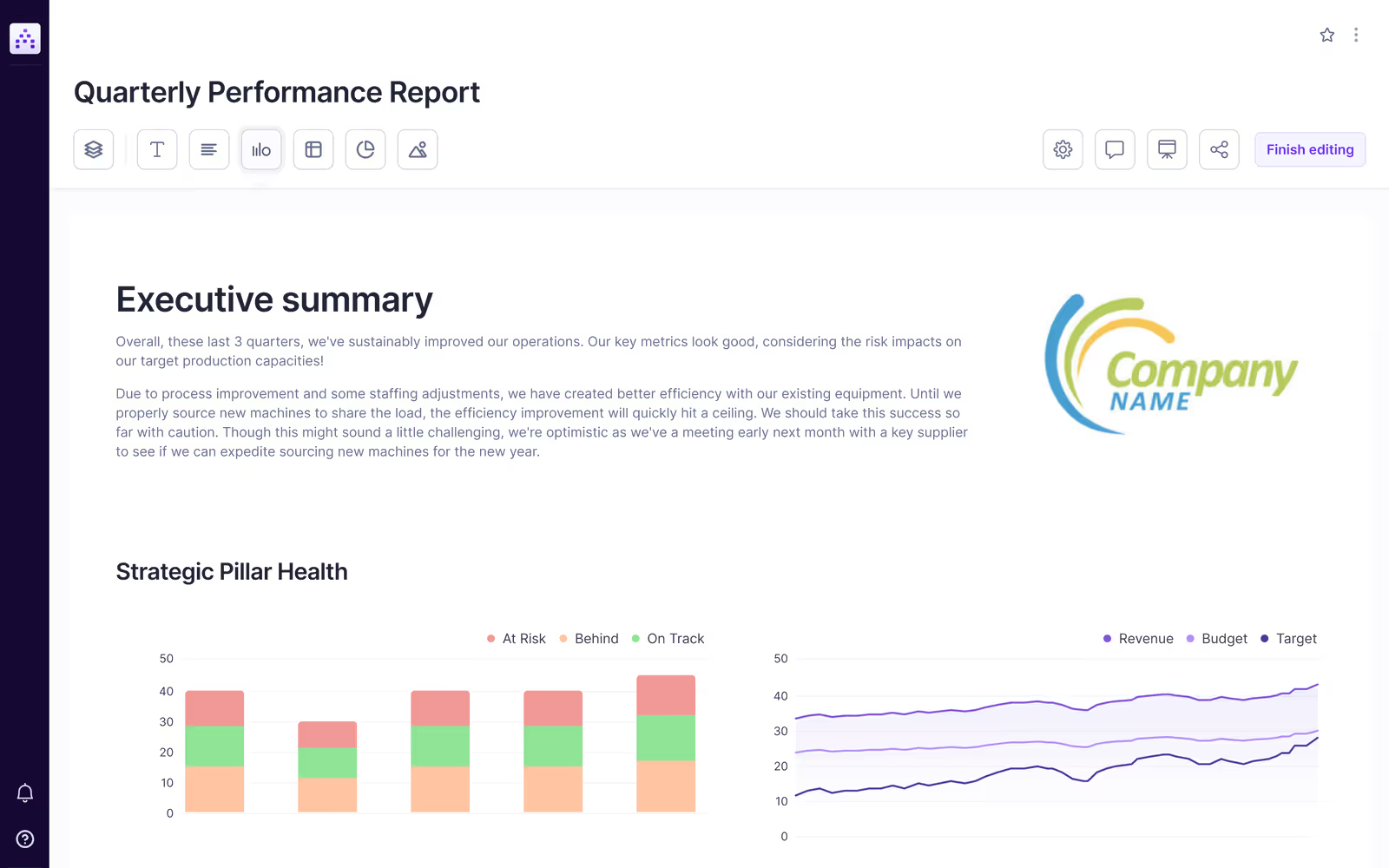Quarterly business reviews aren’t just routine meetings; they’re strategic checkpoints that help organizations chart the optimal route toward success. Unlike the once-a-year pit stop of annual reviews, quarterly business reviews (QBRs) offer a more dynamic assessment that allows businesses to fine-tune their strategy, recalibrate roadmaps, or even set new goals.
Previously, we discussed the importance of a strategy review. Now, we’ll delve deeper into why a quarterly review is an integral part of strategy governance.
We’ll cover what you should do before, during, and after a quarterly business review to ensure it’s impactful.
What Should A Quarterly Business Review Cover?
QBR, essential for strategic alignment and internal information sharing, is a quarterly meeting bringing together department heads, executives, and other business leaders. It involves assessing the business's overall performance, adapting existing initiatives, or developing new strategies as a part of a bigger strategy governance process.
Attendees aim to identify roadblocks, risks, or challenges encountered during the quarter, and to map out strategic initiatives for both short-term and long-term growth.
QBRs should also focus on gathering insights and key takeaways, not just showcasing results.
Here are some high-level questions that must be asked and discussed during the meeting:
- Financial performance: What were last quarter's results? Are we on budget, and what are next quarter's financial projections?
- Resource utilization and operational efficiency: How effectively are resources used? Are there inefficiencies or opportunities for optimization?
- Operational KPIs and alignment: How are operational key performance indicators (KPIs) performing and are they aligned with strategic goals?
- Customer relationships: How did customer success teams perform in the past quarter? Based on customer feedback, have we met customer needs? If not, how can we improve customer experiences and forge stronger relationships?
- Market and competitive analysis: What are the key market trends and competitive challenges? How do these impact our business and strategies? Do we need to adapt existing strategies to attract new customers?
Along with the quarterly reports from department heads, discussions that arise from answering these questions enable businesses to make better decisions and strategies.
How To Prepare For A Quarterly Business Review?
The success of a quarterly strategy review hinges on meticulous preparation. Here’s how to do it:
1. Craft a focused QBR agenda
Begin the preparation process by creating a well-structured QBR agenda. Ensure it’s focused and aligned with the strategic goals and objectives outlined in the previous quarter.
A clear plan sets expectations and allows attendees to prepare relevant questions, discussion points, data, and reports ahead of time.
💡Tip: Distribute this agenda well ahead of the meeting to give participants sufficient time to prepare.
2. Collect data needed for the review
Collect data demonstrating the results delivered within the specified period, including benchmarking against crucial business metrics and competitor comparisons. This not only validates achievements but also provides a broader industry context.
Business leaders or department heads must provide detailed reports in their areas, essential for a comprehensive business performance overview.
Some reports to prepare for the QBR include:

- Financial reports with revenue and expenditure forecasts
- Budgets vs. Actuals reports to assess financial performance against planned budgets
- Customer Satisfaction (CSAT), churn, and retention reports
- Competitive and market analysis reports for an external perspective
- Operational KPIs reports highlighting key performance metrics
Beyond gathering data, analyze it to prepare actionable plans for the QBR. For example, if your data shows a drop in sales, you shouldn’t merely present the related numbers.
You must identify what factors led to the poor performance and have a clear action plan to reverse it in the next quarter. This ensures that QBR meetings are focused and effective without exposing decision-makers to indecision due to a lack of information.
👉How to easily prepare reports with Cascade:
If you find that too much of your time is spent gathering data and creating reports, consider using strategy execution platforms like Cascade, which simplifies the data collection process using integrations across multiple business tools.
Whatever accounting, CRM, or business intelligence tool your team uses, you can integrate them all within Cascade, creating a single powerful source of truth.
Updates from various data sources are fed automatically to Cascade so you can gather accurate information and create beautiful visual reports using the relevant data.

You can also send automatic notifications to team members using email, Microsoft Teams, or Slack to remind them to update various elements they’re accountable for.
How To Run A Quarterly Business Review?
The quarterly strategy review meeting can be divided into three key steps:
%2520(1).avif)
Step 1: Review past performance and goals
Begin with a quantitative analysis of key metrics, such as financial indicators, operational KPIs, and other performance benchmarks. Compare these against targets and previous results to gauge progress towards strategic objectives and assess overall operational efficiency.
Additionally, review any ongoing strategic projects to monitor their status and identify any impediments to success.
Participants of QBR should also revisit any commitments or action items discussed in the last quarter’s QBR. If there was a strategic focus defined or an improvement identified, they should evaluate the progress made from the past review to the current one.
Let’s say you implemented a new sales intelligence tool so the sales team and account managers wouldn’t have to rely on intuition-based approaches. Consider how it affected revenue, the percentage increase in sales, and if this increase offset the tool's cost.
This approach to discussing the impact of previous initiatives ensures there is accountability and follow-through.
Step 2: Open the floor for a strategic discussion
The QoQ performance review helps you identify the gaps between actual performance and targets. This exercise paves the way for the critical next step—strategizing to bridge these gaps.
Focus on the 'WHY' behind the numbers. Analyze reasons for successes and failures, challenging assumptions to uncover true causes.
Next, explore new strategies. For example, if market share loss is linked to a competitor's new product, discuss initiating projects or adjusting strategies to counter competitive threats.
Finish with proactive risk management discussions to identify potential obstacles and challenges that may affect future performance.
Step 3: Prioritize and document decisions
Turn insights from the quarterly review into concrete actions. Leaders must collaboratively determine which initiatives to begin, cease, or maintain, aligning these choices with the company's strategic vision and long-term objectives.
For initiatives involving cross-functional teams, assign timelines and key roles to department heads or business leaders. Make sure it’s clear who owns which initiative for clarity and accountability across departments.
Document every decision, including the underlying reasons, action plans, timelines, and assigned responsibilities. This documentation provides a future reference, fostering transparency and trust among stakeholders.
What To Do After The Quarterly Business Review Meeting?
The true impact of quarterly business review is realized in the actions taken after the meeting. This section outlines crucial steps to maintain momentum and effectively implement decisions made during the QBR.
Relay decisions and develop action plans
Post-QBR, department heads need to communicate the meeting's decisions to their teams clearly and transparently.
Highlight how these decisions are in line with the company's broader strategy. This approach not only builds trust but also gives team members a clear sense of direction.
Next, collaborate with team members and leaders of shared projects to create detailed action plans.
Clearly outline roles and set expectations to ensure everyone understands their part in executing the strategy. Emphasize the significance of each individual's contributions to the broader strategic objectives, fostering accountability and engagement for effective results.
👉Do it in Cascade:
With Cascade, you can build an action plan that aligns with strategic objectives and key business metrics, while ensuring every project or KPI has its owner.
%2520(1).avif)
Teams can also clearly visualize the dependencies of their plans with other teams using the Alignment Map. This visual representation provides a holistic view of an organization’s performance.

Set up processes and tools for progress updates
Without regular monitoring and follow-up, it's easy for initiatives to go off track. Consistent tracking helps identify and rectify issues promptly.
Strategy execution tools like Cascade make this easier by streamlining communication and collaboration to facilitate a smooth flow of information and efficient check-ins between different teams and leaders.
Real-time insights and structured team updates ensure that any roadblocks or risks can be addressed proactively to prevent potential deviations from the strategic course.
The post-QBR phase is instrumental in translating decisions into actionable results. Effective communication, strategic alignment, well-defined roles, and the right tools, such as Cascade, collectively contribute to successfully executing strategies devised during the QBR. This sustains the momentum generated during the meeting and leads the company toward its long-term goals.
Quarterly Business Review (QBR) Template
Cascade makes it easy for you to build custom reports for various use cases within your organization. This means you can stop using clumsy spreadsheets and automate time-consuming tasks like data consolidation and report updating.
With Cascade’s intuitive interface, you can tailor your reports to highlight essential metrics and progress in a clear, concise format.
👉Here’s how:
- Add an executive summary at the top of your quarterly performance report.
- Add headlines and notes to your data to provide additional context.
- Organize a certain set of data with a table format which helps to display more details or drill deeper to get more information.
- Present larger amounts of data with charts.

Additionally, reports in Cascade have a built-in presentation mode that will let you interact with your reports live in meetings.
If you want to reuse the same report for the next QBR, you can simply duplicate it and select the data you wish to include. This will help you maintain consistency and save time.
Using these templates from Cascade not only streamlines the QBR process but also enhances the clarity and impact of the presentations.
💡Sign up for Cascade free and build your first QBR report today. Or get in touch with our strategy execution experts to learn more about Cascade.
💜You can also watch this free on-demand webinar that walks you through reporting in Cascade. No signup required.
Simplify Your Quarterly Business Reviews With Cascade 🚀
When you use Cascade to centralize visibility over your organization’s performance, you gain valuable insights and the ability to proactively address potential challenges that could steer you in the wrong direction.
You can gauge an accurate picture of your strategic performance, which means you can make better business decisions and deliver on the promised results.
Simplify your QBR process with:
- Robust reports for data-driven decisions
- Update templates for real-time insights
- Strategy planner to formulate your strategies and action plans
- Alignment map to visualize how different plans work together
- Over 1,000 integrations to consolidate your existing business tools underneath a unified roof
Ready to improve your QBR? Get a live demo today.






.png)
.jpg)
.jpg)
%20(1)%20(1)%20(1)%20(1)%20(1).png)



